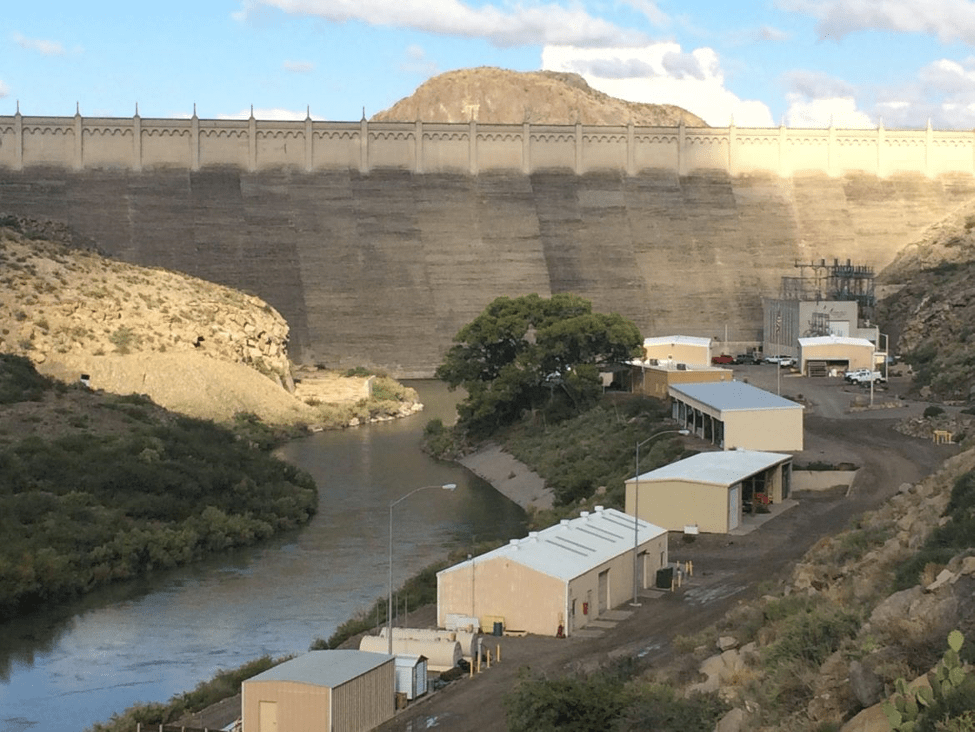Mike Gershon and Nathan Vassar are law partners in Lloyd Gosselink’s 20-lawyer Water Practice Group, which Mr. Gershon chairs.
Texas and U.S. Bureau of Reclamation v. New Mexico and Colorado

Elephant Butte Dam in New Mexico – credit: Laura Paskus
(The states filed a motion to approve a settlement on November 14, 2022. The U.S. indicates that it will oppose the settlement.)
At Issue: Whether New Mexico must limit farmers from pumping groundwater that is hydrologically connected to the Rio Grande to ensure the availability of Rio Grande flows for Texas and Mexico.
Background and Complications: Texas initiated this lawsuit at the U.S. Supreme Court in 2013 to enforce its rights to water at and below Elephant Butte Reservoir under a 1938 interstate compact. The U.S. Bureau of Reclamation intervened to protect its interests in this same compact and also in light of its duty to deliver water to Mexico under a 1906 treaty. New Mexico has counterclaimed that Texas is partly responsible for inadequate surface water flows due to Texas’s unregulated groundwater pumping and allegedly inadequate downstream water management and aging infrastructure. Colorado is named because it is a party to the compact but is not directly affected by the lawsuit. Two irrigation districts and the cities of El Paso and Las Cruces have been participating in the case as “friends of the court” (“amicus curiae”) and have unique interests implicated by the lawsuit and proposed settlement. Notably, the irrigation districts claim rights under a 2008 operating agreement reached with the U.S. Bureau of Reclamation in related litigation. To further complicate matters, New Mexico challenged this 2008 operating agreement in a separate lawsuit filed in 2011, which was stayed when Texas filed its lawsuit in 2013 at the U.S. Supreme Court.
The water-supply disputes have come to a head in recent years because of stresses on water resources caused by drought and arrangements among local New Mexico-based stakeholders to meet local water demand. Texas and the U.S. Bureau of Reclamation claim that New Mexico’s failure to restrict groundwater pumping under state law is the reason New Mexico cannot deliver the quantities of Rio Grande water due under the interstate compact and international treaty. Plaintiffs seek past damages and a judgment that would ensure that they receive the water in the quantities specified in the compact and treaty.
For the past nine years since the lawsuit was initiated, the parties have conducted studies and attempted to resolve their differences under the watch of Judge Michael Melloy, a Special Master appointed by the U.S. Supreme Court.
Recent Developments: On November 14, 2022 (two months before the trial), the states agreed upon a settlement. On January 24, 2023, the court-appointed Special Master will consider whether to recommend that the U.S. Supreme Court approve the settlement. The U.S. announced it opposes settlement because the terms impair the U.S. Bureau of Reclamation’s obligations to deliver water under the 1906 treaty with Mexico and the interstate compact.
The settlement details are currently confidential and are under a court seal unless and until the U.S. Supreme Court approves the settlement.
U.S. Congress’s Response to West Virginia v. U.S. Environmental Protection Agency and EPA’s Next Steps
(Inflation Reduction Act of 2022; EPA’s Request for Information published November 2, 2022.)
At Issue: After the U.S. Supreme Court curbed the U.S. Environmental Protection Agency’s (EPA) rulemaking authority to incentivize clean-energy development in West Virginia v. U.S. Environmental Protection Agency, Congress passed landmark legislation that provides $369 billion in climate and energy programs intended to reduce carbon emissions, and that may breathe life back into EPA’s Clean Power Plan. How EPA may implement its Clean Power Plan to incentivize clean-power projects and whether it will face another legal challenge remain to be seen.
Background: In the summer of 2022, in a case that impacts the extent of judicial deference to federal agency decisions, the U.S. Supreme Court found that EPA’s attempt to enact cap-and-trade regulations to address greenhouse-gas emissions fell outside of the agency’s express authorization. The Court reasoned that on such “major questions,” an agency cannot overstep the authority that Congress provided it. For the first time in its history, the Court adopted the legal doctrine known as the “major-question doctrine,” meaning that on significant policy issues-particularly where Congress has considered taking legislative action but declined to do so—an agency cannot promulgate rules on such matters. Longstanding reliance on “Chevron deference” was not addressed in the Opinion. Still, the decision represents a significant check on agency regulatory authority.
Shortly after the U.S. Supreme Court’s decision, U.S. Congress took action to expressly authorize and fund EPA’s implementation of certain aspects of its Clean Power Plan, using the Build Back Better Act as the legislative vehicle. After the Build Back Better Act passed the House but faltered in the Senate, the $737 billion Inflation Reduction Act of 2022 was introduced as a substitute amendment and ultimately passed both chambers and was signed into law by President Biden on August 6, 2022. The Inflation Reduction Act includes $369 billion for climate and energy programs and authorizes certain aspects of EPA’s Clean Power Plan. On November 2, 2022, EPA published a Request for Information seeking public input to guide the agency’s design of its program to enhance air quality and address climate challenges. In its press release, EPA announced that the legislation created “the largest investment to combat the climate crisis in U.S. history.”
San Jacinto River Authority v. Gonzalez, et al.
(Decided by the Houston Court of Appeals [14th Dist.] on October 6, 2022; the decision was not appealed to the Texas Supreme Court.)
At Issue: In this case about the flooding related to Hurricane Harvey, 85 plaintiffs sought damages based on claims that the San Jacinto River Authority’s (SJRA) release of water from Lake Conroe caused damage to their properties.
Held: The plaintiff’s claims were dismissed because the undisputed evidence shows that the properties would have flooded even if SJRA had not released water from Lake Conroe.
Background: A takings claim requires proof that a governmental entity’s action was intentional and was the proximate cause of damage to a landowner’s property. In this case, the landowners do not live downstream of Lake Conroe. They merely allege in their petition that floodwaters released from Lake Conroe by SJRA caused downstream tributaries to back up, thereby flooding their properties. SJRA’s data, other evidence, and expert testimony proved otherwise. The landowners failed to introduce contradictory evidence and did not preserve their objection to the SJRA’s evidence. Consequently, the landowners could not prove their takings claim. The landowners’ separate gross negligence and nuisance claims were dismissed because the Texas Legislature has not waived governmental immunity for these claims where the damage is only to property.
Join Our Mailing List
Subscribe to Texas+Water and stay updated on the spectrum of Texas water issues including science, policy, and law.

